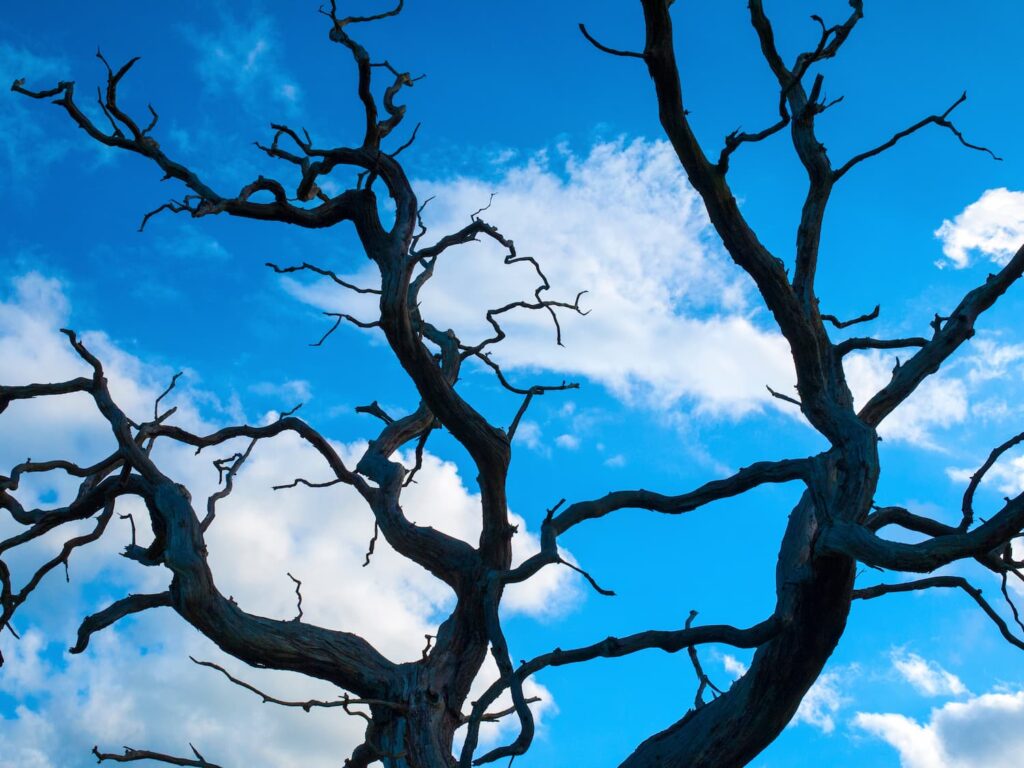Rapid Oak Decline is the rapid decline of Savannah post oak trees due to weather extremes of drought and heavy rainfall, making the trees vulnerable to cankers, root rot, and wood-boring insects.
What is Rapid Oak Decline (ROD)?
Rapid Oak Decline (ROD) is a devastating tree disease that affects oak trees in the United States and Europe. It is characterized by rapid death of the tree, which can occur within just a few years of the initial symptoms appearing. ROD is caused by a combination of factors, including a fungus, bacteria, and possibly other organisms. It has been responsible for the death of thousands of oak trees in the USA and Europe, and is a major concern for forestry professionals and tree lovers alike.
Common Rapid Oak Decline Symptoms
The symptoms of ROD are often the first sign that a tree is infected. These symptoms can include:
- Sudden wilting and yellowing of the leaves
- Dieback of branches, especially in the upper crown of the tree
- Black or dark brown streaks on the bark of the tree
- A foul smell coming from the tree
- Large amounts of sap exuding from the bark
These symptoms are often accompanied by an infestation of oak pinhole borer beetles, which are attracted to the sap exuding from the tree. The beetles lay their eggs in the sap, and the larvae burrow into the tree, feeding on the wood and causing further damage.
What Causes Rapid Oak Decline?
The exact cause of ROD is not fully understood, but it is thought to be caused by a combination of factors. The fungus Ceratocystis fagacearum is present in all ROD-affected trees, and is believed to play a major role in the disease. The fungus attacks the tree’s vascular system, disrupting the flow of water and nutrients and eventually killing the tree.
In addition to the fungus, ROD is also associated with the bacterium Ralstonia solanacearum, which is thought to weaken the tree’s defenses and make it more susceptible to the fungus. Other factors that may contribute to the development of ROD include environmental stress, such as drought or soil compaction, and the presence of other pests or diseases.
How Does It Spread?
Rapid Oak Decline is a particularly difficult disease to control, as it can spread easily from tree to tree. The fungus can be transmitted through the soil, water, and by insects, including oak pinhole borer beetles. The bacterium can be transmitted through the soil, water, and by pruning tools that have come into contact with infected trees.
Prevention and Treatment
The best way to prevent the spread of ROD is to identify and remove infected trees as soon as possible. This can be done by performing regular tree inspections and looking for the symptoms of ROD. If an infected tree is found, it should be removed and the area around the tree should be disinfected to prevent the disease from spreading.
In addition to removing infected trees, there are several other measures that can be taken to prevent the spread of ROD. These include:
- Planting disease-resistant varieties of oak trees
- Avoiding planting oak trees in areas with a history of Rapid Oak Decline
- Using clean pruning tools and disinfecting them after each use
- Avoiding wounding the tree, as this can make it more susceptible to ROD
- Ensuring that the tree has adequate water and nutrients
Conclusion
Despite these measures, Rapid Oak Decline is still a major concern for the forestry industry and for those who love oak trees. If you suspect that a tree may be infected with ROD, it is important to contact a professional arborist or tree specialist for further advice. By taking proactive measures to prevent the spread of ROD, we can help to ensure the health and longevity of our oak trees for generations to come. Are you looking for other Tree Diseases?
Want To Talk To A Certified Arborist?
Do you have more questions about your oak tree? Do you have oak wilt on the trees on your property? Do you have Tree Disease on your property in Texas? Call us today at (817) 799-7808 to talk to our Tree Care Experts.
North Texas Tree Care
As a North Texas-based tree care company, Oakwilt.org does more than just provide industry-leading tree care, we’re here to serve our beloved community. By giving our North Texas trees proper care and maintenance through routine tree check-ups and treating them for oak wilt when necessary, we can promote a greener, more sustainable North Texas community. For help with tree disease treatment and tree nutrition, tree care and tree insect management, soil conditioning, and more, contact our ISA Certified Arborists to get started.
Oakwilt.org is a full-service sustainable tree care company offering residential and commercial tree services in Dallas, Waco, Austin, Fort Worth, San Marcos, San Antonio, DFW, and more. Contact our North Texas tree care experts at (817) 799-7808 and enjoy 5-star rated tree care customer service and the best tree health services in North Texas!
To learn more about North Texas Tree Diseases: Actinopelte Leaf Spot, Anthracnose, Bacterial Leaf Scorch, Crown Gall, Dutch Elm Disease, Hypoxylon Canker, Oak Leaf Blister, Oak Wilt, Rapid Oak Decline, Sudden Oak Death, call our North Texas team of Arborist
at (817) 799-7808 or fill out the contact form.
We’re a little different than the average tree care company.
Learn more about Oakwilt.org ISA Certified Arborists!
Our North Texas-based tree doctors can explain how sustainable tree care services add more value to your properties.
Find out more today by giving us a call today.

